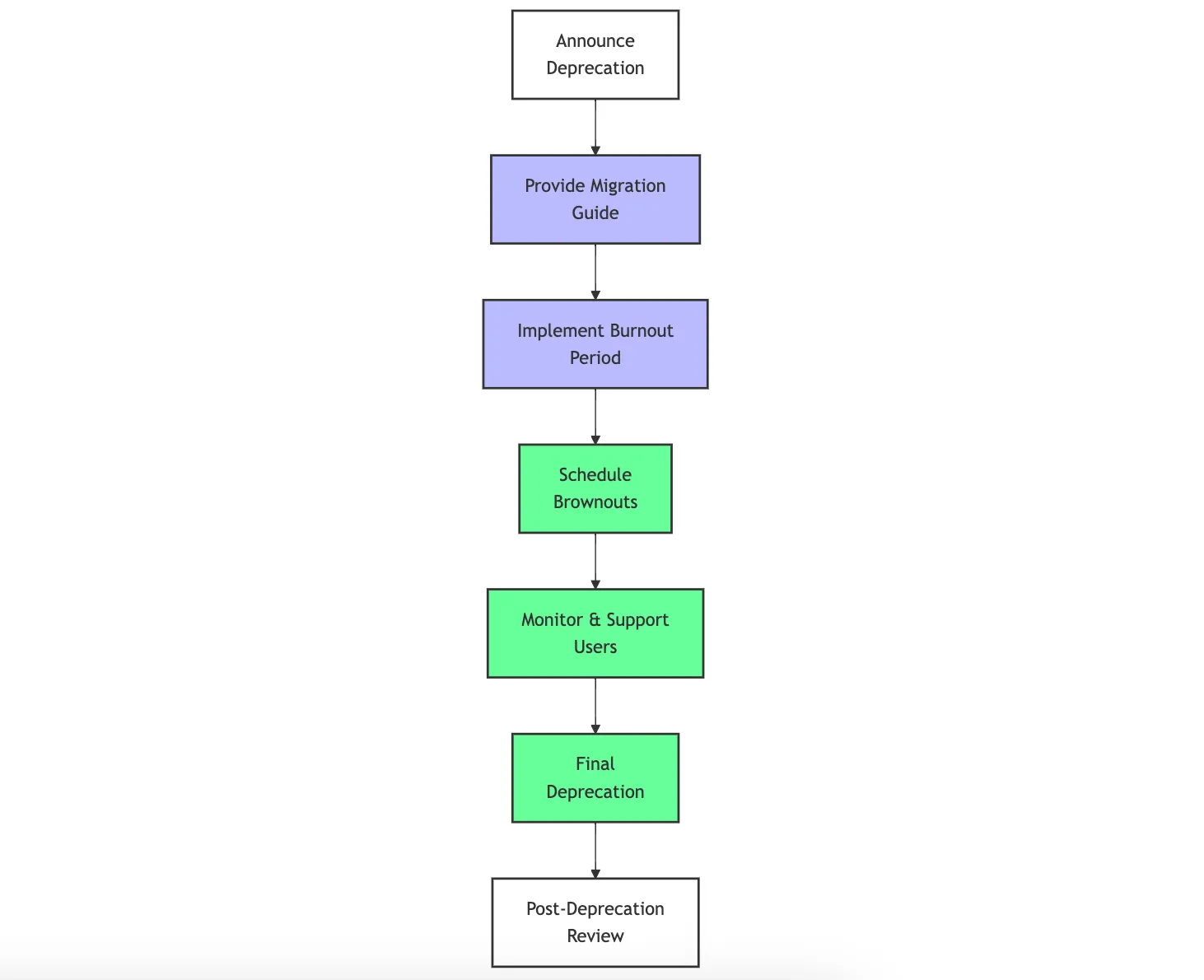· articles · 5 min read
By Ankit JainPackage Deprecation Policy: Best Practices and Graceful Transitions
Learn how to deprecate software packages or APIs gracefully. Avoid user disruption, ensure smooth migrations, and maintain trust in your ecosystem with proven, developer-friendly best practices.
Package deprecation is an essential but often challenging aspect of software development or open source maintainers. As technology evolves, older versions of packages become outdated, unsupported, or even insecure. Managing this process gracefully is critical to maintaining a healthy ecosystem for developers and users. In this guide, you’ll learn how to implement a robust package deprecation policy, the steps to ensure a smooth transition, and insights from real-world examples in the software industry.
Why Package Deprecation Matters
Deprecating a package isn’t just about removing old code—it’s about ensuring the stability, security, and efficiency of the software ecosystem. Poorly managed deprecations can lead to broken builds, frustrated developers, and even system failures. A well-planned deprecation strategy minimizes disruption, communicates clearly, and provides ample time for users to adapt. By handling deprecations thoughtfully, you can maintain trust and foster a positive relationship with your user base.

Key Steps for a Graceful Package Deprecation
1. Announce the Deprecation Early
Why It’s Important: Giving users ample notice allows them to plan and migrate without feeling rushed. A sudden deprecation can catch users off guard and lead to unnecessary friction.
How to Do It: Announce the deprecation at least 6–12 months in advance. Use multiple communication channels, such as email, blog posts, changelogs, and social media, to ensure the message reaches your audience.
Example: In the case of actions/cache, the deprecation of v1-v2 was announced well in advance, with a clear timeline and supported versions. This approach helps users understand what’s changing and how to prepare.
2. Provide Clear Migration Paths
Why It’s Important: Without clear guidance, users may struggle to update their dependencies, leading to frustration and potential errors.
How to Do It: Create detailed migration guides that include code examples, version compatibility tables, and troubleshooting tips. Clearly list the supported versions and tags, as seen in the actions/cache email, which highlighted actions/cache@v4 and actions/cache@v3 as alternatives.
Additional Support: If possible, provide automated tools or scripts to simplify the migration process. This can significantly reduce the burden on users.
3. Implement a Burnout Period
What Is a Burnout Period?: A burnout period is a phase where the deprecated package is still functional but marked for removal. This gives users a final window to update their dependencies.
How Long Should It Last?: A burnout period of 1–3 months is ideal. For example, actions/cache v1-v2 will be fully retired on March 1st, 2025, after a burnout period starting February 1st, 2025.
Reminders: Send regular email reminders during the burnout period. Aim for 3–5 reminders, escalating in urgency as the final deprecation date approaches. This ensures users don’t forget or delay the migration.
4. Schedule Brownouts
What Are Brownouts?: Brownouts are scheduled periods where the deprecated package is intentionally made unavailable. This helps raise awareness and tests the impact of the deprecation.
How to Schedule Them: Plan 2–4 brownouts during the burnout period. For example, actions/cache has brownouts scheduled on February 4th, 11th, and 18th. These brownouts range from 1 hour to 8 hours, depending on the package’s criticality.
Why They Matter: Brownouts act as a “dress rehearsal” for the final deprecation, giving users a chance to identify and resolve issues before the package is fully retired.
5. Monitor and Support
Why It’s Important: Even with clear communication, some users may face challenges during the migration process. Providing support ensures they can complete the transition successfully.
How to Do It: Set up feedback channels, such as forums or dedicated email addresses, where users can report issues or seek help. Track the adoption rate of the new version and identify users who are still on the deprecated version.
Extended Support: For critical packages, consider offering extended support to enterprise users or those with complex dependencies. This can help maintain goodwill and prevent disruptions.
Lessons from Real-World Deprecation Challenges
The software industry has seen its fair share of deprecation mishaps. Here are some notable examples and the lessons they offer:
1. The Left-Pad Incident (2016)
What Happened: A developer unpublished the left-pad package, which was used by thousands of projects, including major frameworks like React and Babel. This caused widespread build failures across the NPM ecosystem.
Lesson: Never unpublish a package without notice. Always provide a deprecation timeline and ensure users have alternatives before removing a package.
2. Event-Stream Vulnerability (2018)
What Happened: A malicious version of the event-stream package was introduced after the original maintainer transferred ownership without proper vetting. This compromised dependent applications.
Lesson: If you can no longer maintain a package, deprecate it responsibly instead of transferring ownership to an unvetted party. Communicate clearly with users about the deprecation and provide secure alternatives.
3. Node-Sass Deprecation (2020)
What Happened: node-sass was deprecated in favor of dart-sass, causing confusion and migration challenges for developers.
Lesson: Provide comprehensive migration guides and clearly communicate the benefits of the new package. Make the transition as seamless as possible for users.
Conclusion
A well-executed package deprecation policy is a hallmark of a mature and responsible software ecosystem and open source mainainers. Announce the deprecations early, providing clear migration paths, implementing burnout periods, and learning from past mistakes, you can ensure a smooth transition for your users. Remember, the goal is not just to remove old code but to empower your community to move forward with confidence.
Further Reading:
- The art of deprecation - Why we need to start this process
- Lessons from the LEFT-PAD incident - A major incident in the NPM/NodeJS community
- Deprecate a web API: Best Practices? - For API deprecation guidance